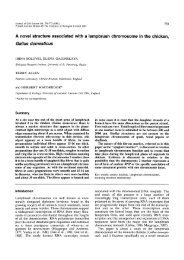Sutton Common Updated project design - University of Exeter
Sutton Common Updated project design - University of Exeter
Sutton Common Updated project design - University of Exeter
You also want an ePaper? Increase the reach of your titles
YUMPU automatically turns print PDFs into web optimized ePapers that Google loves.
Task 10: Geoarchaeology analysis and report production<br />
Task 11: Collate, cross-reference and edit specialist reports for monograph text<br />
Task 12: Integrate specialist reports with archaeological information. This integration and the<br />
modelling <strong>of</strong> palaeoenvironmental data in relation to the archaeology will be achieved through<br />
the application <strong>of</strong> models <strong>of</strong> spatial patterning <strong>of</strong> vegetation types based upon the palaeorecord<br />
in addition to the known hydrology <strong>of</strong> the site. The GIS can provide a forum for bringing<br />
together all data sources into one inter-relational format. This will form the platform for<br />
interpretation, reconstruction and illustration.<br />
Task 13: Final dating and phasing<br />
Task 13.1: Produce final scheme <strong>of</strong> phases <strong>of</strong> activity at <strong>Sutton</strong> <strong>Common</strong><br />
Task 13.2: Update site plans and text in accordance with the final phasing (linked to task 2.4)<br />
and produce final plans <strong>of</strong> the different phases <strong>of</strong> activity for publication, based on GIS maps<br />
Task 14: Production <strong>of</strong> reconstruction drawings<br />
Task 14.1: Produce a birds-eye view <strong>of</strong> <strong>Sutton</strong> <strong>Common</strong> in the Iron Age within a wide landscape<br />
setting<br />
Task 14.2: Produce a birds-eye view <strong>of</strong> <strong>Sutton</strong> <strong>Common</strong> in the Iron Age<br />
Task 14.3: Produce three detailed reconstruction drawings, including one <strong>of</strong> the western and/<br />
or eastern gateways.<br />
Task 15: Undertake outstanding data-gathering<br />
Task 15.1: Update regional context if the site, revisit South Yorkshire and West Yorkshire<br />
SMRs, NMR, and undertake full analysis <strong>of</strong> recently published material dated to the Bronze<br />
Age, (including the bronze objects ritually deposited in wet places in the region (cf. Parker<br />
Pearson and Sydes 1996) and Iron Age through the British and Irish Archaeological<br />
Bibliography (BIAB) and the ISI Web <strong>of</strong> Knowledge. The recent publication by the YARFF<br />
team: The Archaeology <strong>of</strong> Yorkshire; an assessment at the beginning <strong>of</strong> the 21 st century<br />
(Manby et al. 2003) may form a starting point, but it should be noted that the Iron Age<br />
archaeology <strong>of</strong> West and South Yorkshire was not considered here!<br />
Task 15.2: Produce a national overview <strong>of</strong> information on the Iron Age lowland/marsh-forts in<br />
England and Wales. This forms an important part <strong>of</strong> new research, aimed at providing a<br />
national framework for the <strong>Sutton</strong> <strong>Common</strong> site, and drawing attention to a (growing) number<br />
<strong>of</strong> Iron Age lowland enclosed sites, that have previously not been fully recognised. Note that<br />
the recent publication <strong>of</strong> the 1 st century BC ringwork at Coveney (Evans 2003) does not include<br />
such an overview, only reference to sites similar in morphology in the Cambridgeshire Fens<br />
and one such site in Oxfordshire.<br />
Task 15.3: Produce additional reports:<br />
• Digital excavation archive, to be submitted to the Archaeological Data Service, York. The<br />
digital resource will include a complete GIS database that will incorporate the surface DEM,<br />
water table data, trench outlines (for 1998, 1999, 2002 and 2003) and a coverage showing<br />
contexts. The latter will be linked to a spatial database that will include context interpretations<br />
and dating where appropriate to enable interrogation <strong>of</strong> the overall database, in addition to<br />
providing the potential for generating phase diagrams and functional diagrams (e.g. positions<br />
<strong>of</strong> 4-post structures). Depending on discussions with the publisher <strong>of</strong> the monograph, we<br />
may also wish to consider to include a CD with relevant data in the book, in addition to this<br />
material being available on-line through the ADS<br />
• Iron Age wood technology: the archaeology <strong>of</strong> <strong>Sutton</strong> <strong>Common</strong>, S. Yorkshire: by Gavin<br />
Thomas, c. 6000 words for Environmental Archaeology or Journal for Wetland Archaeology<br />
• Vegetation history <strong>of</strong> the Humberhead Levels based on the <strong>Sutton</strong> <strong>Common</strong> material: by<br />
Benjamin Gearey, Allan Hall and Harry Kenward, c. 5000 words for Environmental Archaeology<br />
or regional natural history journal.<br />
30
















